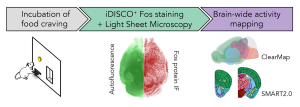 Hot Off the Press – November 21, 2022
Hot Off the Press – November 21, 2022
Summary
Relapse to reward seeking progressively increases during abstinence, a behavioral phenomenon termed incubation of craving. Mechanistic studies of incubation can lead to novel relapse treatments. However, previous studies have primarily used rat models and targeted region-by-region analyses, and a brain-wide functional atlas of incubation of reward seeking is lacking. We established a behavioral procedure for incubation of palatable food seeking in mice and applied whole-brain activity mapping with Fos as a neuronal activity marker to identify the functional connectome of this incubation. Like rats, mice showed incubation of food seeking during abstinence. Using two complementary activity mapping approaches, we identified a brain-wide pattern of increased neural activation that mirrored incubation of food seeking after 60, but not 1 or 15 abstinence days.
Publication Information
Incubation of palatable food craving is associated with brain-wide neuronal activation in mice Journal Article
In: Proceedings of the National Academy of Sciences, vol. 119, no. 45, pp. e2209382119, 2022.
